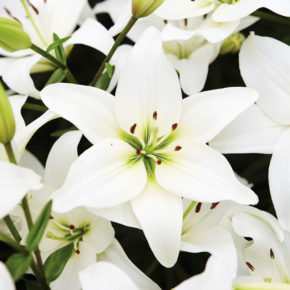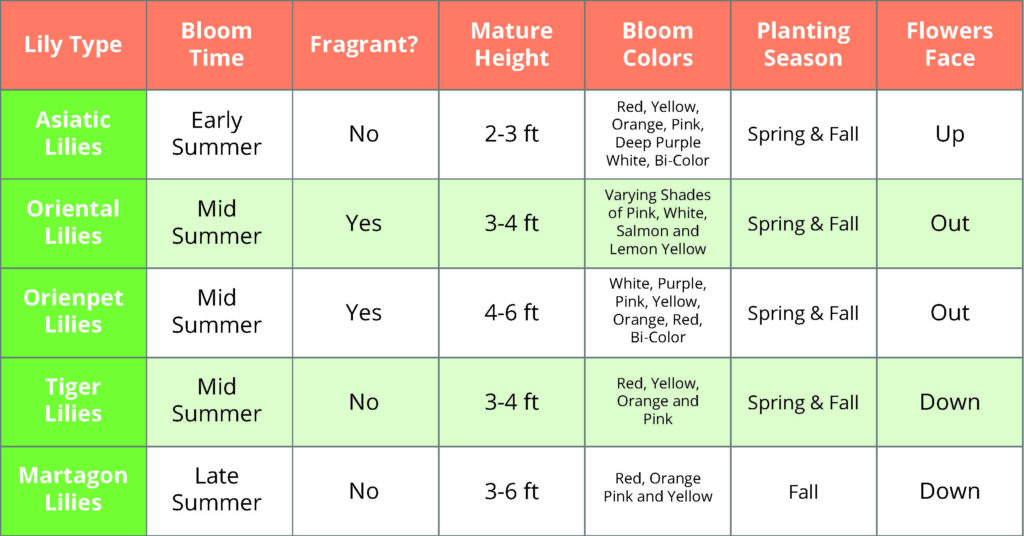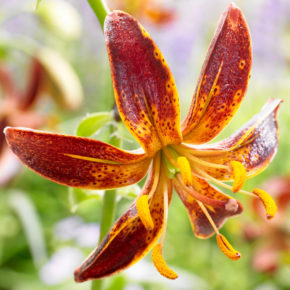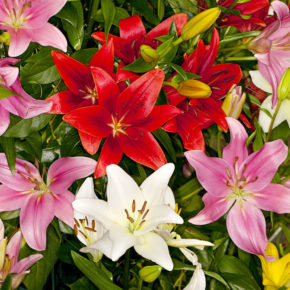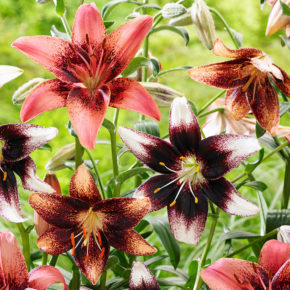 Lily bulbs produce showy, colorful blooms throughout the summer months. Lilies are considered easy to grow flower bulbs. They have few requirements for success. While lily bulbs can be planted in spring they grow especially well when planted in fall. If lilies are your favorite flower, you are in luck as there are many options for fall planting. Perhaps you are new to gardening and in search of easy to grow bulbs to start planting. Continue reading to learn everything you need to know about planting lily bulbs this fall.
Lily bulbs produce showy, colorful blooms throughout the summer months. Lilies are considered easy to grow flower bulbs. They have few requirements for success. While lily bulbs can be planted in spring they grow especially well when planted in fall. If lilies are your favorite flower, you are in luck as there are many options for fall planting. Perhaps you are new to gardening and in search of easy to grow bulbs to start planting. Continue reading to learn everything you need to know about planting lily bulbs this fall.
The Who, What, When, Where, Why and How of Planting Lily Bulbs this Fall
1.) Who Should Plant Lily Bulbs?
People in hardiness zones 3-9 will find these perennial flowering bulbs will grow well in their landscape and gardens. If you have experience planting lilies but want to expand your lily and perennial garden consider planting lilies this fall. New gardeners will enjoy how easy lilies are to grow! Lily bulbs grow well in the majority of the United States, so as long as you have a sunny location planting lilies is for you!
2.) What Kind of Lily Bulbs Should I plant?
The world of lilies is expansive. With so many lily varieties to choose from it is possible to have a lily blooming in your garden for over 6 weeks during the summer.
While companies like Holland Bulb Farms and Tulip World offer many spring-planted lilies, there are also plenty of options for fall-planted lilies. Holland Bulb Farms has 20 varieties of lily bulbs for fall planting to choose from. Their selection includes a few mixed color packages, as well as Asiatic Lilies, Oriental Lilies, Orienpet Lilies, Tiger Lilies, and Martagon Lilies. Tulip World also sells Asiatic Lilies and Oriental Lilies in larger package counts with 8-10 bulbs per package for fall planting. These bulk lily packs are a great value on the most popular lily varieties.
To the untrained eye, most lily varieties look similar. However, there are key differences among the most popular groups of lilies.
Oriental Lilies and Orienpet Lilies are fragrant, tall and their flowers face outwards.
Asiatic Lilies are the first lilies to bloom in summer with upward-facing blooms and a large assortment of colors available.
Tiger Lilies and Martagon Lilies both have blooms that hang down with petals that curve; speckled flowers in warm colors are the main features of these unique lily blooms.
For a complete comparison on this chart, you will find the main differences between Asiatic Lilies, Oriental Lilies, Orienpet Lilies, Tiger Lilies, and Martagon Lilies.
3.) When Should Lily Bulbs be Planted?
Lily bulbs can be planted in spring or in fall. Some varieties of lilies are only available in spring and not in fall and vice versa. Fall may be a better time for you to plant lily bulbs based on your availability and schedule. Take your air temperature and the soil temperature into consideration when deciding what season to plant lily bulbs.
The ideal time to plant is when the soil is cool but before it freezes. If lilies are planted in soil that is too warm they will not be as vigorous. Conversely, planting too close to when your ground freezes may not allow enough time for roots to establish prior to their winter.
Planting lilies this fall in northern climates (hardiness zones 3-5) will be best in late September, October, and early November.
Gardeners in areas with milder winters such as hardiness zone 6 and 7 will find that planting in mid-to-late October through November will produce the best results. Since lilies are some of the fall-planted bulbs that grow well in hardiness zones 8 and 9, people in those areas will want to plant in late November through December. Not sure of your hardiness zone? Use this zone finder here to find out.
4.) Where Should I plant Lily Bulbs?
Plant lily bulbs in full to part sun for the best growth and blooms. Lilies are fairly easy to grow. However, they have a requirement for the planting location. It is critical that they are planted in soil that has adequate drainage.
Since most lilies grow at least 3′ tall place them in the back of the perennial garden. Lilies go dormant a few weeks after they finish blooming. Take this dormancy into consideration when planning your summer garden. By planning for the dormant period you won’t have empty spaces in your garden after the lilies are done blooming. Planting late summer blooming perennials in front or near your lilies will help fill the space when they are dormant.
5.) Why Should I Plant Lily Bulbs in Fall?
While you’re planting your tulips, daffodils, allium, and other fall favorites you may as well add some lilies to the area since you are digging and planting in fall. Temperatures are most favorable for planting lilies during the fall season.
Certain varieties like Fairy Morning Martagon Lily and Arabian Night Martagon Lily are only available for fall planting. If you want these unique lilies also known as Turk’s Cap Lily in your garden, fall would be the best time to plant them.
Many of your other perennials will be dormant or going dormant. Seeing empty spaces in the garden is easier in fall compared to spring when all your spring-blooming bulbs are emerging. These are among a few reasons that planting lilies in fall is best. Add the surprise element next spring when you forgot they were planted and you have even another reason that fall planting is best for lilies.
6.) How do I plant Lily Bulbs?
Lilies are best planted in groups of 3-5 bulbs per planting hole. Dig a hole 12″ wide and 6-8″ deep, placing the bottom of the lily bulb at the 6-8″ mark.
A bonus about lily planting is the side that faces up is noticeably pointy, and roots are fairly noticeable on the bulbs. Since roots grow into the ground the roots should be touching the ground while the pointy end is facing up.
Once you have the lily bulbs in the planting hole, cover the bulbs with soil until the soil is even with ground level.
After planting water the planting area to eliminate air pockets. Adding water after planting also helps to encourage a deep and healthy root system. Since you are planting in fall and the bulbs are preparing for dormancy you do not need to provide additional water after the initial planting. Note: If you are in a warm climate and anticipate that the bulbs will emerge shortly after planting you will want to water them as normal once you see sprouts emerge.
Happy Planting = Happy Lily Blooms
Even though your lilies won’t emerge until the following summer, planting and planning for them this fall will save you work and result in happier lily bulbs. These colorful summer-blooming bulbs are diverse in height, bloom time, and shape. Now that you have everything you need to know about planting lilies this fall, what are you waiting for? Start choosing your favorite lilies to add to your perennial beds and borders!


